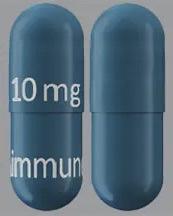Palforzia and Alcohol/Food Interactions
There is 1 alcohol/food/lifestyle interaction with Palforzia (peanut allergen powder).
Peanut Allergen Extract Food/Lifestyle
Major Food Interaction
ADJUST DOSING INTERVAL: Coadministration of peanut allergen extract with alcohol may potentiate the risk of allergic reactions, including anaphylaxis. According to some studies, alcohol is an augmenting factor influencing immunological mechanisms that can induce more severe allergic reactions and is involved in up to 15% of cases of anaphylactic reactions. Proposed mechanisms include an increase in allergen absorption from altered permeability of the intestinal epithelial barrier, enhancing mast cell and basophil activation, and an increase in serum IgE concentrations. In addition, according to product labeling, administration of peanut allergen extract during a fasting state may potentiate the risk of allergic reactions, including anaphylaxis. The exact mechanism has not been elucidated.
MANAGEMENT: To minimize the risk of allergic reactions, including anaphylaxis, some authorities recommend alcohol not be consumed for 2 hours before, or 2 hours after taking peanut allergen extract. If alcohol cannot be avoided, withholding or decreasing peanut allergen dosage should be considered. Peanut allergen extract should also be administered with an evening meal and not within 2 hours of bedtime.
References (3)
- (2023) "Product Information. Palforzia (peanut allergen extract)." Aimmune Therapeutics
- (2022) "Product Information. Palforzia Level 1 (peanut allergen extract)." Aimmune Therapeutics UK Ltd
- Munoz-Cano R, Pascal M, Araujo G, et al. (2023) Mechanisms, Cofactors, and Augmenting Factors Involved in Anaphylaxis https://www.ncbi.nlm.nih.gov/pmc/articles/PMC5623009/pdf/fimmu-08-01193.pdf
Switch to consumer interaction data
Palforzia drug interactions
There are 139 drug interactions with Palforzia (peanut allergen powder).
Palforzia disease interactions
There are 3 disease interactions with Palforzia (peanut allergen powder) which include:
More about Palforzia (peanut allergen powder)
- Palforzia consumer information
- Check interactions
- Compare alternatives
- Drug images
- Side effects
- Dosage information
- During pregnancy
- FDA approval history
- Drug class: allergenics
- En español
Related treatment guides
Drug Interaction Classification
| Highly clinically significant. Avoid combinations; the risk of the interaction outweighs the benefit. | |
| Moderately clinically significant. Usually avoid combinations; use it only under special circumstances. | |
| Minimally clinically significant. Minimize risk; assess risk and consider an alternative drug, take steps to circumvent the interaction risk and/or institute a monitoring plan. | |
| No interaction information available. |
See also:
Further information
Always consult your healthcare provider to ensure the information displayed on this page applies to your personal circumstances.


